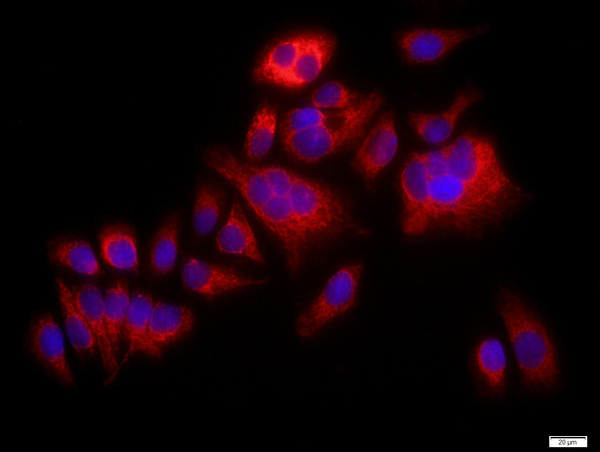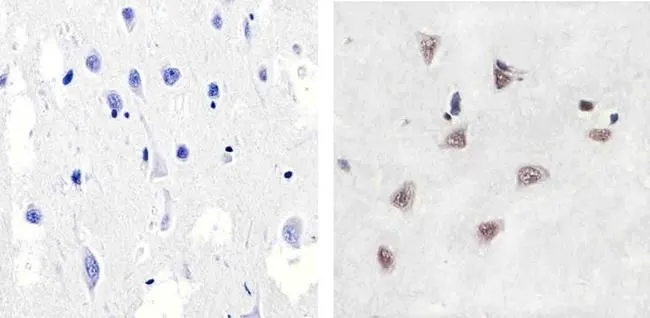p38 MAPK antibody [N1C3-2]
GTX110720
ApplicationsImmunoFluorescence, Western Blot, ImmunoCytoChemistry, ImmunoHistoChemistry, ImmunoHistoChemistry Paraffin
Product group Antibodies
ReactivityCanine, Human, Mouse, Rat
TargetMAPK14
Overview
- SupplierGeneTex
- Product Namep38 MAPK antibody [N1C3-2]
- Delivery Days Customer9
- Application Supplier NoteWB: 1:500-1:3000. ICC/IF: 1:100-1:1000. IHC-P: 1:100-1:1000. *Optimal dilutions/concentrations should be determined by the researcher.Not tested in other applications.
- ApplicationsImmunoFluorescence, Western Blot, ImmunoCytoChemistry, ImmunoHistoChemistry, ImmunoHistoChemistry Paraffin
- CertificationResearch Use Only
- ClonalityPolyclonal
- Concentration0.44 mg/ml
- ConjugateUnconjugated
- Gene ID1432
- Target nameMAPK14
- Target descriptionmitogen-activated protein kinase 14
- Target synonymsCSBP, CSBP1, CSBP2, CSPB1, EXIP, Mxi2, PRKM14, PRKM15, RK, SAPK2A, p38, p38ALPHA, mitogen-activated protein kinase 14, CSAID-binding protein, MAP kinase 14, MAP kinase Mxi2, MAP kinase p38 alpha, MAX-interacting protein 2, cytokine suppressive anti-inflammatory drug binding protein, mitogen-activated protein kinase p38 alpha, p38 MAP kinase, p38 mitogen activated protein kinase, p38alpha Exip, stress-activated protein kinase 2A
- HostRabbit
- IsotypeIgG
- Protein IDQ16539
- Protein NameMitogen-activated protein kinase 14
- Scientific DescriptionThe protein encoded by this gene is a member of the MAP kinase family. MAP kinases act as an integration point for multiple biochemical signals, and are involved in a wide variety of cellular processes such as proliferation, differentiation, transcription regulation and development. This kinase is activated by various environmental stresses and proinflammatory cytokines. The activation requires its phosphorylation by MAP kinase kinases (MKKs), or its autophosphorylation triggered by the interaction of MAP3K7IP1/TAB1 protein with this kinase. The substrates of this kinase include transcription regulator ATF2, MEF2C, and MAX, cell cycle regulator CDC25B, and tumor suppressor p53, which suggest the roles of this kinase in stress related transcription and cell cycle regulation, as well as in genotoxic stress response. Four alternatively spliced transcript variants of this gene encoding distinct isoforms have been reported. [provided by RefSeq]
- ReactivityCanine, Human, Mouse, Rat
- Storage Instruction-20°C or -80°C,2°C to 8°C
- UNSPSC12352203
References
- Lee SC, Shen CY, Wang WH, et al. Synergistic Effect of Ginsenoside Rh2 Combines with Ionizing Radiation on CT26/luc Colon Carcinoma Cells and Tumor-Bearing Animal Model. Pharmaceuticals (Basel). 2023,16(9). doi: 10.3390/ph16091188Read this paper
- Zhang X, Lian X, Li H, et al. Taxifolin attenuates inflammation via suppressing MAPK signal pathway in vitro and in silico analysis. Chin Herb Med. 2022,14(4):554-562. doi: 10.1016/j.chmed.2021.03.002Read this paper
- Hsu YC, Chuang HC, Tsai KL, et al. Administration of N-Acetylcysteine to Regress the Fibrogenic and Proinflammatory Effects of Oxidative Stress in Hypertrophic Ligamentum Flavum Cells. Oxid Med Cell Longev. 2022,2022:1380353. doi: 10.1155/2022/1380353Read this paper
- Sun Y, Chen X, Xie Y, et al. TRPM7 promotes lipopolysaccharide-induced inflammatory dysfunction in renal tubular epithelial cells. Immun Inflamm Dis. 2022,10(7):e641. doi: 10.1002/iid3.641Read this paper
- Fu L, Shi Z, Chen B. Deleted in lymphocytic leukemia 2 induces retinoic acid receptor beta promoter methylation and mitogen activated kinase-like protein activation to enhance viability and mobility of colorectal cancer cells. Bioengineered. 2022,13(5):12847-12862. doi: 10.1080/21655979.2022.2076482Read this paper
- Qian X, Zhang Y. EZH2 enhances proliferation and migration of trophoblast cell lines by blocking GADD45A-mediated p38/MAPK signaling pathway. Bioengineered. 2022,13(5):12583-12597. doi: 10.1080/21655979.2022.2074620Read this paper
- Hong J, Gwon D, Jang CY. Ginsenoside Rg1 suppresses cancer cell proliferation through perturbing mitotic progression. J Ginseng Res. 2022,46(3):481-488. doi: 10.1016/j.jgr.2021.11.004Read this paper
- Cui X, Sawashita J, Dai J, et al. Exercise suppresses mouse systemic AApoAII amyloidosis through enhancement of the p38 MAPK signaling pathway. Dis Model Mech. 2022,15(3). doi: 10.1242/dmm.049327Read this paper
- Lu CC, Yang JS, Chiu YJ, et al. Dracorhodin perchlorate enhances wound healing via β-catenin, ERK/p38, and AKT signaling in human HaCaT keratinocytes. Exp Ther Med. 2021,22(2):822. doi: 10.3892/etm.2021.10254Read this paper
- Chiu YJ, Tsai FJ, Bau DT, et al. Next‑generation sequencing analysis reveals that MTH‑3, a novel curcuminoid derivative, suppresses the invasion of MDA‑MB‑231 triple‑negative breast adenocarcinoma cells. Oncol Rep. 2021,46(1):pii: 133. doi: 10.3892/or.2021.8084.Read this paper




